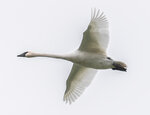



This is the final installment of Beak of the Week.
It has been a semi-regular piece in The Chronicle since May. Among others, Beak of the Week has featured sparrows, backyard feeder birds, raptors, cranes, grosbeaks, goldfinches, killdeer, ducks and geese.
As the year draws to a close, it is a fitting time to celebrate a bird whose fanfare brightens the dark, dreary late fall in Southwest Washington. A call more triumphant than a goose’s. One that can be heard from more than a mile away, preceding white silhouettes against usually gray skies.
It is the trumpeter swan. Like Simon & Garfunkel’s “Hazy Shade of Winter,” these birds are around when leaves are brown and there’s patch of snow on the ground.
Swans arrive in Southwest Washington in mid- to late-November seeking warmer weather. Most swans in Washington are migrants who breed and spend the summers in Alaska and British Columbia, according to Margaret Smith, executive director of the Trumpeter Swan Society, headquartered in Minnesota.
Flocks of trumpeter swans can be found in abundance in the Skagit Valley. In smaller batches, they’re frequent visitors to corn and wheat fields in the Chehalis River Valley, namely Adna, Porter and Elma, where lowland fields become winter wetlands.
Recent conservation efforts have brought swan populations back from near extinction. In 1974, Porter-area farmer Jay Gordon said his father saw four swans. By 1999, Gordon’s fields would host hundreds of the large, white birds.
The heaviest flying bird native to North America, the average adult male trumpeter swan weighs more than 26 pounds. The very large waterfowl require a 100-foot runway to take flight, according to the Cornell Bird Lab.
Trumpeter Swans form pair bonds around ages 3 or 4, according to the Bird Lab. Pairs stay together throughout the year in migratory populations. The swans mate for life, with some exceptions.
Smith, in a previous interview with The Chronicle, called them “magnificent birds.”
Their wingspans can surpass 6 feet across. They fly south to escape extreme cold weather.
One threat to swan habitat in Washington has been the transformation of dairy, corn and potato farms into fruit and berry farms, Smith said. The society has worked with Gordon, policy director for the Washington Dairy Federation, to increase awareness on the benefits of dairy land for the swans.
A contract with the society requires him to graze, burn or mow 35 acres of land each winter for swan habitat. Gordon calls the area his “swan easement.”
Bird watchers are encouraged to report tagged swans on the Trumpeter Swan Society website at https://www.trumpeterswansociety.org/welcome.html. To report a sick or injured swan, call the Washington Department of Fish and Wildlife at 360-902-2936.